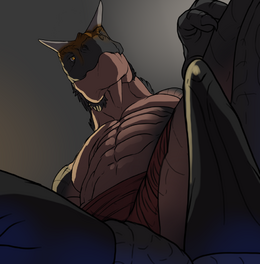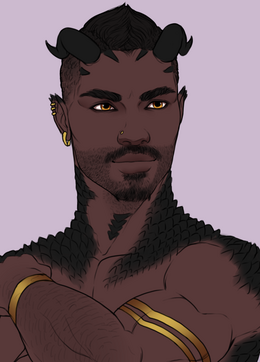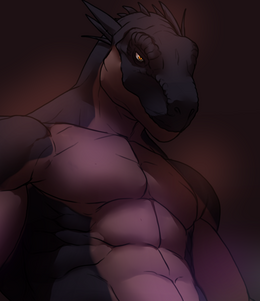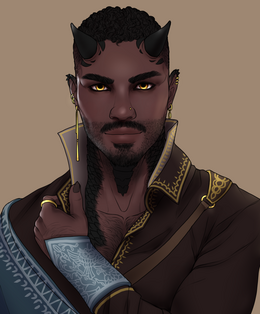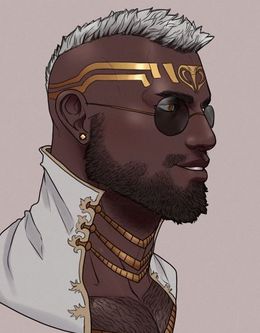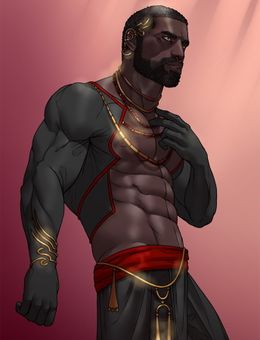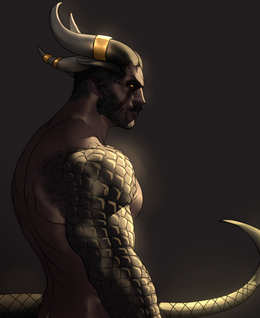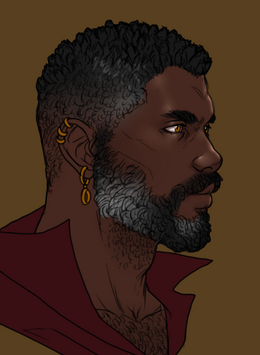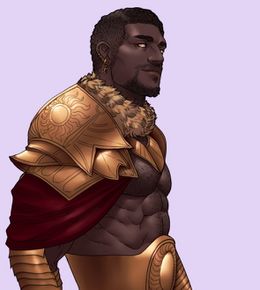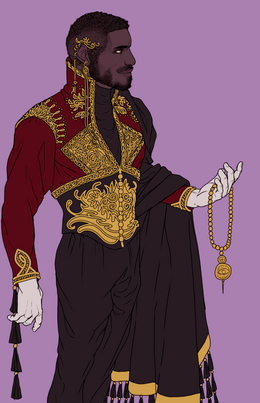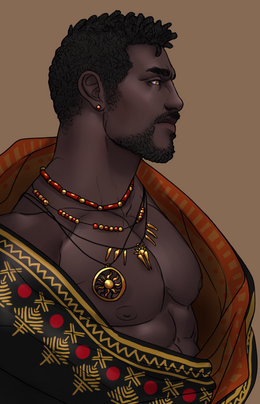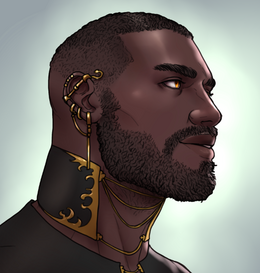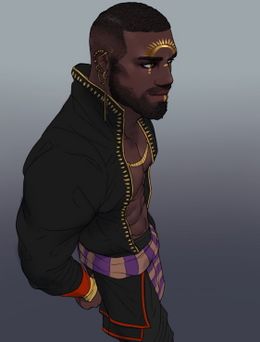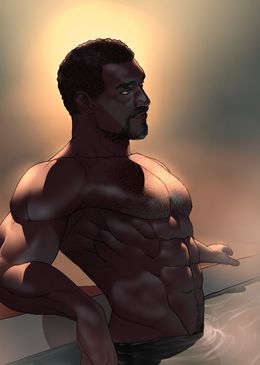Songaskia: Difference between revisions
No edit summary |
m (→Free Packs) |
||
| (101 intermediate revisions by 5 users not shown) | |||
| Line 1: | Line 1: | ||
{{Info races | {{Info races | ||
|image = | |image = Songisplashi.png | ||
|pronunciation = Song-gah-ski-an | |pronunciation = Song-gah-ski-an | ||
|classification = [[Human]] | |classification = [[Human]] | ||
|subraces = N/A | |subraces = N/A | ||
|nicknames = Drake-kin | |nicknames = | ||
*Desert-Drakken (praising) | |||
*Horned Raiders (derogatory) | |||
*Drake-kin (praising) | |||
|languages = [[Sofaal]] | |languages = [[Sofaal]] | ||
|naming = | |naming = Malian names found on earth [http://www.top-names.info/names.php?S=M&P=MLI] | ||
|distinction = Half-Draconian descendants of the Bronze Dragons | |||
|distinction = Half-Draconian descendants of the | |maxage = 250 | ||
|maxage = | |||
|eye = Amber/Orange reminiscent of fire | |eye = Amber/Orange reminiscent of fire | ||
|hair = Jet black | |hair = Jet black, snow white, sandy brown/blonde, or dark-muted-brown. | ||
|skin = | |skin = [[File:Songskin.png]] | ||
|}} | |}} | ||
In the far-off | [[File:Songdragonhater.png|260px|thumb|right|This Sofawaati Form Songaskian is wondering if you are a little Dragon hater.]] | ||
[[File:Scalevariance.png|260px|thumb|right|Songaskians can manifest whole or partial Black Dragon aesthetics on their body.]] | |||
== | [[File:Songdragonkeel.png|260px|thumb|right|Songaskians grow much larger and imposing in their Sofawaati Forms.]] | ||
[[File:Songhornsy.png|260px|thumb|right|Songaskians are exceptionally stylish and well dressed no matter what they wear (or how little).]] | |||
In the far-off sands of [[Farahdeen]] stands the towering pearl cities of the [[Songaskian Masaya]], home to the heirs of the Elders and the Great Old Ones. While commonly covered in desert, the total landmass owned by the Songaskians is twice the size of the Regalian Empire, and is commonly said to have the most well-equipped and trained professional army in the world. The Songaskians, being relative newcomers to the world, have rapidly mobilized onto the global stage, and played pivotal roles in all the recent events. Some of the last remaining remnants of the [[Dragons]], the Songaskians have proclaimed themselves the inheritors to the guardianship of the world, a title once held only by the majestic winged creatures that roamed the skies and lorded over the mortal [[Races]]. Poised to strike from the great cities built by their [[Sariyd]] forerunners, the Songaskians spread their proverbial wings across the oceans, gathering resources and manpower to achieve their own goals of a great utopia of biodiversity and life, which they of course are the leaders of through benevolence. Others yet continue to follow in the footsteps of their draconian ancestors, living lives of study, self-exploration, and development to become the worthy descendants the Dragons wished them to be. | |||
==Core Identity== | |||
To be a Songaskian is to be the heir of Dragons, the inheritor of a powerful legacy of majestic and magical creatures that once controlled the elements of the world, but perished with time. Even with the return of Dragons in the modern era, Songaskians stand apart from their distant kin in that they have taken a different path. They do not attempt to revive what once was, but herald a new era with themselves as the preservers of the living and those who would combat the clutches of death and infection. Many Songaskians travel the world, seeking out places where death or evil holds sway, and fighting to protect the living while making lots of friends along the way. They can frequently be seen stalking places where the dead have risen, and where [[Magic]] has made even the kindest of people into self-serving autocrats. Their approach is often self-righteous, but always with good intentions, even if it comes across with a snark and smirk. | |||
===Magic versus Infection=== | |||
While most Dragons see Magic as an infection period, with any type of Occult or [[Aberrant]] being instantly an unwanted transgression, Songaskians have a more nuanced stance. They believe that Magic by nature is a tool, one to be used and nurtured, but that true infection is the evil will of death that infects the soul through over-indulgence. Songaskians believe that Magic by itself can never be harmful even when practiced for selfish reasons, but excessive use of Magic invites a corruption of the soul that turns someone evil. For Songaskians, the terms infection and evil mean the same thing, and are interchangeably used. They believe evil is infectious, it can spread between people, and the only way to stop it, is to extinguish evil Magic users and dead things. [[Undead]] are usually exempt from this, but Songaskians are always suspicious of the sentient Undead, believing there may be great evil hidden in them that is just waiting to get out, because all things dead by nature want to spread death. | |||
=== | ===Desert Homeland=== | ||
The Songaskians feel that Farahdeen belongs to them. Their Dragon ancestors once roamed its skies, and as such, they see it as a holy land, their holy land as the children of Marik. This is the core of their war with the [[Qadir]]: while no one remembers why the war started, it is continued by Qadir nomads' trespassing, and the trench front line between the Songaskian Mage-priests and Qadir clockwork engineers. They export this conflict to other countries, including Regalia, where street fights between Qadir and Songaskians are still very frequent. | |||
===Harmonic Preservers=== | |||
=== | While Songaskians believe Farahdeen only belongs to them and those who have chosen their path in line with the Dragon Worship religion, they see the rest of the world as chaotic and in need of stewardship. The Songaskians go out and solve other people’s problems for them, even if they do not like the solutions levied by the Songaskians. The Songaskians see themselves as the heirs of the so-called “Mantle of Creation”, which is an ideological concept that proposes that one species/race/entity is always at the forefront of defending life from death. The Songaskians have claimed this mantle for themselves, and impose that pro-life stance wherever they can. | ||
==Design== | |||
===Mental Characteristics=== | |||
Songaskians have a respect for all life. While they do not shy from fights, or killing if they have to, they spare even the lowest critters and insects as long as they can. This attitude also extends to being welcoming and charitable hosts to all people (except the Qadir). They do genuinely see themselves as benevolent, and try to do good by others, though sometimes this makes them come off as know-it-all or patronizing when they don't mean to. Songaskian culture is quite open, jovial, and self-expressive, leading to a people overall very comfortable with parties, drinking games, gambling, and a strong sense of community. | |||
===Physical Characteristics=== | |||
Songaskians have two different appearances, their human form and their Dragon form. Their human form is always African-coded, identical to African-coded [[Ailor]] with very dark skin. However, there are some differences. Songaskians have amber-colored, slightly fiery irises. While most Songaskians have black hair, some can also have snow-white hair, hair colored like the sand of the desert dunes, or a very dark and muted brown. Songaskians are average to tall when compared to Ailor, and usually have a fairly athletic build with wide shoulders, even when not maintaining their physique. Their hair can be coily, curly, straight, or wavey, but also matted or braided to form dreads. Songaskians do have a male and female biological sex distinction, however, both are capable of carrying a child to term and conceiving, and as such, the Race is functionally intersex. A curious aspect about the Songaskians, is that they can turn their hair into fire, which is cold to the touch but does still create enough light to act like a lantern in the dark for them. | |||
===Sofawaati Form=== | |||
All Songaskians have a Transformation called Sofawaati Form, in which they assume a body more similar to the Bronze Dragons (Bronze Dragon Marik on the [[Dragon Worship]] Page. Songaskians don't need to Transform all in one go however, they can also manifest any of the individual elements (for what the whole transformation may look like, reference the art on this page). Manifestations of the Sofawaati Form are: A dragon-like head, Dragon-horns, black or black-like or bronze scales on their whole or parts of their body, Draconic-tail, digitigrade legs with Dragon-claws, pointed ears. Sofawaati Form is not a Disguise (even if the face changes), and does not grant wings. | |||
==Heritage Traits== | |||
When designing a Character, Proficiency Points allow for a limited Ability selection with Point Buy Packs. Heritage Traits adds free Packs and Mechanics on top of that to help with cultural themes. Free Packs grant Abilities usually, while Mechanics change the way a character functions in Roleplay through subtle, and usually out of Combat ways. In essence, Mechanics just add aesthetic flair that invest in the niche of each culture. Free Packs never raise Proficiency Points, but the character must be able to purchase them normally. (ex. if a character is a certain Affinity that locks them out of a category, they cannot take that specific free pack and must choose the alternative option.) If a Free Pack grants Magic of some type, that Magic can be of any Alignment the character can normally choose, or limited to a select alignment, which will always be written in the Free Pack description. | |||
=== | Mixed Heritage characters (i.e. characters born from two parents of different Cultures) may take one parent's 'Free Packs' and mix and match up to 5 Mechanics from both parents, although some Peoples cannot produce Mixed Heritage children (due to Magical/Fantasy reasons). | ||
===Free Packs=== | |||
* Songaskia gain the Magical variant of [[Adapt_Point_Buy#Safeguard_Pack|Safeguard Pack]] for free, or choose one pack from [[Prayer Point Buy]]. | |||
* Songaskia gain the [[Athletic_Point_Buy#Steady_Body_Pack|Steady Body Pack]] for free, or choose one Pack from [[Cleric Point Buy]]. | |||
== | ===Mechanics=== | ||
* Songaskians cannot become Undead, unless they are forced to do so, or request it from, an Ordial Entity. They can also choose to become a Primal Revenant on death. | |||
* Songaskians are immune to harm from heat or fire sources (unless they are Magical), and do not suffer decreased visibility or choking hazard in a sand-storm. | |||
* Songaskians do not have night vision in the dark, but can switch to infra-red sight allowing them to see people in pure darkness (but not through walls!). | |||
* Songaskians may be able to do a perception check on Dragon Sites/Temples/Event Characters, and unlock additional interactions or learn more information. | |||
* Songaskians can feel whether a Soul has passed into the afterlife, The Beyond, or is still alive (or Undead/Spirit) in Aloria, if they know their true name. | |||
[[File:Saysomethingabouttattoos.jpg|260px|thumb|right|Tawhroon (on the forehead and sides) are very popular among the Songaskians, always with actual gold leaf or dust, and with long flowing lines.]] | |||
[[File:Tightclothes.jpg|260px|thumb|right|Songaskian Clothing has only two extremes: Either extremely loose and wide, or extremely short and tight. Elastan is particularly popular.]] | |||
[[File:Songdragonhoren.png|260px|thumb|right|Songaskian Black Dragon scale is as tough as armor, which is why some just run into battle with only a set of pants.]] | |||
[[File:Songshair.png|260px|thumb|right|Songaskians do gray around the 150 year mark.]] | |||
[[File:Absonqassoum.jpg|260px|thumb|right|Songaskian bodyguards are very much in demand in Regalia, as they are considered very jovial and familial guards that add a personal touch.]] | |||
[[File:Diplomatsong.png|260px|thumb|right|The Songaskian Masaya has some of the most skilled diplomats (or spies) in the non-Slizzar world that often puts the Regalian State to shame with how much information they acquire from just being at parties.]] | |||
[[File:Lookatthisdrip.png|260px|thumb|right|Black, Red, and Gold are frequently recurring color themes for the Songaskians. They tend to avoid blue as much as possible as this is a Qadir color.]] | |||
[[File:Omgsopretty.png|260px|thumb|right|Many Songaskians crop their hair very short or shave it of altogether to be bald, thus being able to have more sunlight touch their skin, which is seen as pious.]] | |||
[[File:Prettytattoman.jpg|260px|thumb|right|Songaskian ambassadors use physical charm as much as wit to widen their understanding of their habitat.]] | |||
[[File:Saunapg.jpg|260px|thumb|right|Songaskians in general find Regalia way too cold for their liking. They are the most common users of Regalian saunas to sit in an environment that reminds them of Farahdeen.]] | |||
==Language== | |||
The Songaskian language called Sofaal is based on the real life equivalent of Bambara, which is chiefly spoken in the country of Mali. It is an entirely unique language in [[Aloria]] in that it has no relation to any languages spoken anywhere else, and has a couple of words which are reminiscent of Wyrm Tongue, or Dragon language. The Songaskians have a simple first and last name naming principle, using names that are common in the countries of Mali, Burkina Faso, Niger, and Mauritania, but avoiding names that have obvious arabic or muslim references such as Mouhammed or Abdoul. Songaskian names are non-gendered, meaning they can apply to female-presenting, male-presenting or non-binary identifying individuals. | |||
'''Songaskian name examples:''' Djene, Moulaye, Ailou, Fode, Hama, Konate, Alou, Soumba, Deni, Traore, Bintou, Nana, Rama, Mamadou, Adama, Oumar, Sisko, Bouacar, Mane. | |||
Additionally, Songaskians have a hidden name called Doumara, or their Soul-name. This name is given at birth and kept very personal and secret, shared only to the deepest of friends and lovers of a Songaskian. Songaskians believe this name has power, and that they should take exceptional effort to make sure a Demon of the Void or Exist or Ordial planes never learns of it, because if they do, they might gain control over the Songaskian’s soul. The Doumara is always a noun or adjective or combination in the Sofaal language that has some relation to the Songaskian’s birth. For example, a Songaskian might be born in the afternoon, so their name becomes Tiléden, or afternoon child in Bambara. Another example might be Siramugaman, meaning orange, referencing the child was born in orange cloth. | |||
==Religion== | |||
Songaskians by far and large follow [[Dragon Worship]], though they have their own name for it, called Mussaktu, or "gratefulness for living". Those Songaskians that worship Dragons generally consider themselves somewhat apart of the other Dragon faiths, because they are the inheritors of Dragons, believed to have been made out of the bodies and souls of the Black Dragons who perished in the Great Storm. As a result, Songaskians consider themselves more hallowed among equal Dragon worshipers, and generally mostly bestow their favor on Marik, who is called Masa in the Songaskian Language. It is not unheard for for a Songaskian to change their favored Dragon from Marik to any other Dragon however, it is unusual, but life events sometimes dictate a necessity to change ideology, especially in Regalia where some of the haughty stances encouraged by Marik worship become untenable. Songaskians also don't just exclusively worship Marik, other Dragons are also encouraged and shrines for them built, it is just that Marik is generally given a more preferential place, even if not chosen as favored Dragon. | |||
==Families== | |||
Half Songaskians are celebrated among the Songaskians. From a cultural point of view, they are just Songaskians to the Songaskian people. Half Songaskians always have the same skin-tone as full Songaskians (if you do not want to play a Half-Songaskian with Songaskian skin-tone, play a Half-something else). | |||
===Childhood=== | |||
Songaskian childhood is fairly standard, similar to Ailor households. Songaskians are strictly anti-slavery, but also have a fairly misunderstood anti-prisoner sentiment. Within the Songaskian Masaya, Regalian prisoners who were imprisoned during the First and Second Songaskian Wars found that they would not be thrown into dungeons like Regalia normally does, but were instead given to Songaskian families to live with them and often even raise or interact with their children. While precautions were made to ensure the prisoner would not harm the children, the goal was always to teach the children internationalism, other Race perspectives, and often even language or fostering interest in all things foreign. Indeed, the same thing was applied when the Regalian Prince was captured, and imprisoned at the palace together with the Songaskian Massya, who would later inherit his father’s throne, applying his friendship with the then-future Regalian Emperor to broker peace with Regalia. As such, many Songaskian children have memories of these prisoner-tutors, who would often end up becoming life-long friends. The only exception to this are the Qadir, who are never taken prisoner. | |||
===Adulthood=== | |||
Songaskian adulthood is fairly high quality, especially in the Songaskian Masaya. The Masaya has a very well-developed social system, and while nobility and politics are absolutely cut-throat with whole families being purged for saying the wrong thing, commoners live an absolute life of bliss, aided with Magic (but never Technology!). Each person contributes to their ability and is afforded to their needs, creating a weird culture shock when Songaskians reach Regalia and find that Regalia has severe poverty and racial discrimination, a concept that is foreign in Farahdeen (except, of course, against Qadir). Most Songaskians are assigned jobs in adulthood by the state, which is sometimes why some Songaskians seek the life of an adventurer in the wider world, being able to decide where to go by themselves. | |||
===Romance & Gender Norms=== | |||
Songaskians apply the more common romance norm of monogamy, though since Songaskians are functionally intersex, they don’t really have a gender-dominant society or a concept of mother and father. Parents are always parents, and same-sex relations are very common, upwards to half of the Songaskian race is same-sex oriented. Gender norms also don’t really exist, the only gender norm that sort of exists is that most Mussaktu Priests are expected to be women. Why this is the case is not known, it just has always been that way. Songaskians are generally apathetic to all other matters of gender identity. | |||
==Politics== | |||
Songaskian society is dominated by the Songaskian Massya, which is their equivalent of Emperor or Empress, not to be mistaken with Masaya, which means Empire. The Songaskian Masaya is very similar to the Regalian Empire, in that the Songaskian state has an autocratic nobility that oversees the day-to-day running of the Empire, while the Massya himself is mostly a cultural and religious figurehead. Unlike Regalia, however, the Songaskian Masaya does not have hereditary nobility. Nobility among the Songaskians can be given and taken away in single generations, and all children must always progress with ambition and ferocity, while most Nobles in Regalia can afford to become lazy and settle in sedentary positions of just using their privilege and finances without lifting a finger for it. Laziness among the Songaskian nobility is punished immediately with having privileges revoked. Songaskians often rise to nobility through major feats, like winning important battles or passing an important reform. Some families do function with effective hereditary nobility, but only because they push their children every generation to do better and to re-earn their position in life. | |||
==History== | ==History== | ||
The Songaskians are relatively new to the world, having only been around for several centuries. When exactly these events took place is hard to record, but their first appearance was directly following the Great Storm in Farahdeen that would see the Sariyd Empire destroyed and their empty and abandoned cities being taken by the Songaskians as their new pearl cities. The Songaskians essentially replaced the forerunners of the Qadir, with only the modern Qadir being descendants of the people who lived in the poor hinterland provinces, far away from the center of the Sariyd Empire. The Songaskians see their birthplace in Kouriyasui, a series of holy mountains in their faith where the Black Dragons took their last stance against the Sariyd army of machines and automata that had been built to destroy them. After decades of warfare, the Dragons were finally pushed into a corner, and in their dying moment, they cast a spell so terrible as to summon the desert winds against the Qadir, grinding their machines to a halt, and choking them out as the sun was darkened in the sky. Immediately afterwards, the Dragons disappeared, and the Songaskians stepped out of the sandstorms, settling the land. | |||
Since then, the Songaskians have established the Songaskian Empire, or the Masaya, which controls the majority of Farahdeen save for the Al-Alus peninsula, where an eternal battle still rages between the Qadir and Songaskians. No actual casualties have been recorded for over a hundred years, with the Qadir content on sending waves after waves of Clockwork machines into battle, which the Songaskians answer with armies of necromancer minions and magical apparitions to defend their land and try to push the Qadir back. The war frontline is a hellscape that no living thing treads, with constant hordes of zombies attacking towering machine giants. These zombies don’t count as corrupted dead, because they are mindless and controlled by Magic, the Songaskia often terming them Necroservants. The Songaskians still want to push the Qadir out of the continent, and the Qadir still want to push the Songaskians back and retake some of their lost Sariyd heritage, so the war continues on. | |||
===Emperor or Puppet=== | |||
There is a very lively debate around what the Songaskian Massya actually is. For several years now, the Songaskian Masaya has been in a near state of Civil War. During the [[First Songaskian War]], the Regalian Empire was defending against the Massya’s father who wished to establish geopolitical dominance of the Songaskian Masaya over Regalia. When that war ended and the Massya died, his child son was put on the throne, who had positive connections to a Regalian Prince who was imprisoned at the palace after the first war for a while. This Massya suddenly took a very pro-Regalian stance, and suffered a coup at the hands of his uncle who then enforced a very anti-Regalian stance, resulting in the [[Second Songaskian War]], which Regalia won, to re-establish the young Massya on the throne, and exile the uncle to the far provinces. | |||
Since this period, the uncle has encroached on the Massya’s political power base again, however the Massya is not completely powerless either. The Masaya is caught in a very delicate balance of ideology between pro and anti Regalian, and it is not so easy to really call either side entirely in favor or against. For example, the uncle still uses [[Unionist]] advisors and Regalian weapons, while the Massya is also known to command espionage missions to Regalia to discover state secrets. Indeed, many Regalian nobles still believe the Massya to be a child, however he has become a capable and witful young man who seems to have his own agenda, even if his lingering fondness for Regalia remains. He is often accused of being a puppet in the Masaya also, but these accusations are hardly ever rested in fact and more often than not political theater as a distraction for other motivations. Songaskian politics are complicated, and anyone portraying them as a black and white comparison only displays their own ineptitude to understand the nuance and subtext of the Massya and his uncle’s interactions. | |||
===Qadir Nuance=== | |||
Qadir relations are nuanced. The hatred Songaskians feel for Qadir is not eternal, meaning, there are circumstances in which Qadir can become “good” Qadir in the eyes of Songaskians. They require one of two circumstances. One, the Qadir converts to Mussaktu thus implicitly rejecting Sariyd heritage and demands, thus calling for Al-Alus to convert also. Two, the Qadir acknowledges and proclaims that Farahdeen belongs to the Songaskians and the Mussaktu faithful, and that they will not try to reclaim what they lost, thus explicitly rejecting the state of Al-Alus as illegitimate. Under these circumstances, Qadir and Songaskians can become friends, though both choices are obviously problematic for the Qadir’s relations with revanchist Qadir who still want to retake what they believe is theirs by right. | |||
===Songaskian Pearl Cities=== | |||
Farahdeen is a massive desert many times larger than the entire Regalian Empire, with only select established routes of travel going through the many deserts and with even less Pearl Cities that are actually inhabited. There is a total of 14 (2 held by Qadir) cities, though Kouriyasui is not really considered a city as it is largely inhabited by the dead of the Choir of Dreams. As such, all Songaskians who were born in Farahdeen were either born en route to, or in one of the following cities: | |||
* '''Timbardena''' is the northernmost Pearl City with the most lush climate, being situated between a series of oases. Timbardena is the only city with a forest, and as such is a major exporter of furniture. It is a very isolated city that can conventionally only be reached by traveling by the coast, or through Kouriyasui. | |||
* '''Kourimou''' or Kourimoptoi depending on one’s spelling, is a coastal Pearl City that harvests the majority of the pearls in Farahdeen, in the bay of Kouriya. The pearls harvested here are used to produce the special paste for the bone-white walls of the Pearl Cities that prevent sand from sticking to the stonework. | |||
* '''Diabaleni''' is a major shipyard Pearl City responsible for building the majority of the ships of the Songaskian fleets. | |||
* '''Moptou''' or Moptoi depending on one’s spelling, is a coastal Pearl City that is conventionally seen as the piracy capital of the Masaya, where the majority of the corsairs depart from to [[Essalonia]]. | |||
* '''Diernali''' is the main export staple market for Songaskian [[Gold]], and also the Pearl City that has the highest Gold production. As such, some remark that the city reeks of death, on account of large hordes of Necroservants controlled by Ordial Mages performing basic labor tasks around the city, and the actual living having their abodes on a raised platform high above the lower streets. This city is as a result also infested with crime, because zombies can’t witness theft and literally don’t live to tell the tale. Those born in Diernali are not lovingly called anything, in fact they are often called greedy and self-serving, Ourat being a term that is used to describe a person who is “like a zombie addicted to gold”. | |||
* '''Shaaq-Turnaal''' is an average Pearl City, though it is distinguished in modern times as being the first city to fall to the Regalian army during the Second Songaskian War. This city is incidentally also where the then Emperor of Regalia [[Cedromar]] commanded the execution of 40,000 unarmed civilians to show the Songaskian Masaya that Regalia would not be afraid to use genocide against the Songaskians to speed up the end of the war, forcing the Massya’s uncle to the negotiating table and eventually losing the throne for the sake of preventing future civilian slaughter. | |||
* '''Massoilagui''' is an average Pearl City that has nothing special about it besides that it held out long enough to see the end of the Second Songaskian war without being taken, despite numerous sieges. Massoilagui as a city has a particular immigration policy against [[Dwarves]] and [[Eronidas]], remembering the savage destruction these two Races inflicted on the countryside near it during the siege under the Regalian banner. | |||
* '''Bou Gasagou''' is an average Pearl City. There is nothing overtly remarkable about it beyond the extensive libraries that are built in the city’s so-called Marouats, tall spire-like buildings with pointed roofs that stick out far above the Pearl walls, from where scholars perch on the highest balcony to shout debating dissertations at each other across the roofs. Those born in Bou Gasagou are lovingly called Boubou’s, which is a way of saying “someone who likes to shout at others”. | |||
* '''Sikassaro''' is an average Pearl City, but it is distinguished in that it has a very large [[Allar]] minority living in it. Sikassaro as a Pearl City has a very diverse biosphere in the ocean near it, which is a very popular harvesting location of ingredients used in [[Alchemy]]. | |||
* '''Korbamakora''' is the capital of the Songaskian Masaya which sits defensively between the Khatil-Assatola and Khagargoro deserts. It is a massive city with 3 million inhabitants, potentially being the second most inhabited city in the world behind Regalia’s 4 million. This city also has the largest dome construction underway, with the majority of the support infrastructure already being complete, and work having been started on the final enclosing dome that should make the city its own self-contained environment. Korbamakora is also home to the Massya’s palace, the Songaskian state offices, and the headquarters of both the College of Priests and the religious institutions. Songaskians born in the capital are lovingly called Korbas, which is a way of calling them stuck-up or self-righteous, even for a Songaskian. | |||
* '''Dogono''' is a major Pearl City oriented around the military, with massive parts of the city just being military barracks and training centers. Dogono is in theory the frontline should the Qadir ever push north, but the Songaskians who go through compulsory military training rarely if ever see combat. However, this does not mean they are ineffective and untrained. Far from it, Dogono is known as a dogged training facility that yields some of the most well-trained warriors, and even accepts foreigners so long as they stay for 3 years, and accept Songaskian lifestyle practices and rules. Songaskians from this city are lovingly called Dogours, which means something like a bucket-head (common mockery of soldiers who wear helmets) in Sofaal. | |||
* '''Kankagner''' is the last of the Songaskian Pearl Cities in the south that is ostensibly the front line between Qadir-held Al-Alus and the Ouelessa desert (which in full is called Ouelessa boule fassa bagougou, meaning “the sand which swallows the world whole”). This city is home to the largest collection of Ordial mages in the world, who continue to fuel the never ending border conflict between the Masaya and the Qadir states to the south. | |||
* '''Kouriyasui''' is technically a Pearl City (it has the Pearl walls), but nobody lives in it, and it is purely being maintained by an army of dead constructs to keep it clean for religious ceremonies by the Priests. The Pearl City sits at the foot of the Kouriyasui mountains, and as such is a place where the dead pass to be grafted into the mountains in their final resting place. The city's houses have mostly been converted to mortuaries, and anyone who works in the city lives in smaller settlements outside of its walls. | |||
* '''Al-Alus''' is technically a Pearl City, though it is not held by the Songaskians. Al-Alus became the unofficial Qadir capital after the loss of the Sariyd Empire, and though it has grown in recent years, it remains much smaller than the other Pearl Cities, having barely 400,000 inhabitants. | |||
* '''Istiniyye''' is the smallest Pearl City in existence, on the very tip of the Al-Alus peninsula housing less than 200,000 (Qadir) inhabitants. Istiniyye was in the process of being constructed when the Sariyd Empire collapsed. While the Qadir spent a long time trying to continue construction, they simply did not have the resources the Sariyd Empire did, which is why vast sections of the Pearl walls were never finished. | |||
===Song Awnisu=== | |||
While Songaskians are generally understood to be able to become 250 years old, this is not actually true. Songaskians don’t actually die, ever, but become functionally catatonic at around 250 years old, after which they must be brought to the Wall of Dreams in Kouriyasui, the holiest of places to the Songaskians, deep in the Farahdeen desert. The Song Awnisu or “Goodnight, people of Songaskia” in [[Sofaal]], refers to the fact that these dying Songaskians are grafted into the mountains of Kouriyasui, where they join the Choir of Dreamers. These Songaskians don’t actually die, but join a collective consciousness that dreams their past lives in vivid details, and even allows Songaskians who visit Kouriyasui to experience these past lives and memories in visions simply by being there. Songaskians do not fear the coming of death, as even Songaskians who fall in battle do not fully die, and can still be grafted into the mountains that once witnessed the dying echoes of the Black Dragons. The only death the Songaskians fear, is having their hearts and minds stolen by [[Demons]], for they will not be able to witness the choir of past lives. | |||
* | ==World View== | ||
World View is optional content that helps give Songaskians flavor and depth. | |||
* | * Curiously enough, Songaskians are actually okay with [[Vampire]]s. So long as they try to adapt to civil society and live by the rule of law (and can secure their own blood cattle without slavery), then the Songaskians see no reason to force cure them, kill them, or imprison them. | ||
* The Songaskian super welfare state is almost entirely paid for in Gold. The Songaskian Masaya is in fact the largest gold producer in the world, with zombie drones, or Necroservants, used to mine the gold and refine it, and then sold in bales to other countries. Even though Regalia has no active trade treaties with the Songaskian Masaya, Songaskian Gold always ends up in Noble banks as Bales of Gold. | |||
* | * Songaskian relation to the Undead and [[Bintaar]] is complicated. Ordial to them is treated in the same way as Void and Exist, in that it is a dimension to draw power from. Death is inherently evil, but using the power of death to remove the evil of death is not. This is why Ordial mages who create Necroservants to fight machines of war are good, but sentient Undead fighting the living are not. Songaskians often cleanse (kill) the Undead in Farahdeen. | ||
* Tawhroon is a popular aspect of fashion: the Songaskian art of using semi-permanent gold paint on the body, usually in straight or curved lines. Many Songaskians practice it, as it is meant to showcase opulence and wealth. | |||
* | * Songaskians culturally despise wearing headcovers, because it blocks them from the sun. They believe that if they wear hats or any kind of head cover, they are denying the sun’s ability to peer into their soul and judge them, which is a crime against their god. This was part of Songaskian repression in the past in Regalia, requiring all faithful to wear hats in order to avoid being expelled or burned for being heretics. Luckily this law was done away with long ago, but Songaskians still feel resentment over such targeted humiliation. | ||
* | * The Songaskians don’t really have a concept of separation of religion and state. The Mussaktu Priests are very powerful in daily life, and they are even enforcers of Masaya law, which lacks its own military guard force. Criminals that cannot be rehabilitated are executed with the sundial, allowing the sun to be focused and reflected off massive golden sun disks to redirect to a focal point and incinerate the criminal. | ||
* | * The Songaskian Masaya is the only country/state in the world that has compulsory military service. Once Songaskian children reach adulthood, they have to go through 3 years of compulsory military education unless they are sent abroad on state business, or leave before then, or become adventurers. In this compulsory state service they are taught military formations, orders, and usually combat with a spear and shield. Mages have their own battalions where they are taught combat magic and restraint to prevent the Magic from tipping over in their soul. | ||
* | * Within the Masaya, other racial minorities do exist, but many exist in bubbles. There is not so much racial discrimination as there is a general lack of knowing exactly what to do with them. While Songaskians have a clear place in Songaskian society, the Songaskians are not yet able to determine what to do with, for example, Eronidas immigrants. As such, many of them default to the entertainment industry, working in theaters, bars, and restaurants. | ||
* | * A Songaskian sport frequently engaged in is Sand-ball, a sport with a circular arena filled with fine sand. On each end of the arena is a goal with a goalkeeper in front of it. Only the goalkeeper can touch the ball, all other players (5 on each team) must use sand telekinesis to move around the arena hovering on sand-devils, using sand telekinesis to spout forth sand and shoot the ball around the arena. The game is played in 3 sets of 15 minutes, with the highest amount of times of the leather ball going through the goal of the opposing team being the winner. | ||
* | * The Songaskia have a group within each of their cultural divisions called the Dongilitariku. Part musician, part story-teller, it is their job to record or rely events of the past or recent years with musical flair for celebrations and to pass on their cultural traditions to the next generation. Outsiders at parties or receptions often do not understand the stories being told, as they are usually only in the Songaskia tongue, but the dancing and music that goes along with them is entertainment enough to keep their attention. | ||
* Songaskian parents are often very “tough love” towards their children. Whether as adventurers or in military service, there is a period of 3 years during which Songaskian children are completely cut off from their families to learn how to survive on their own. After this time, a joyous reunion is held and the member is welcomed back into the family. Sometimes this does not go as planned, and Songaskians end up stranded and anxious for the judgment of their family, never returning. | |||
* Songaskian food more often than not involves stews and earthenware pots with closed-circuit cooking environments in a large fireplace or oven. Songaskians are communal eaters and it is very common for a Songaskian to make a dinner for 10, and invite neighbors over every evening for dinner, so long as they bring the alcoholic beverages and the party attitude. | |||
* An often overlooked topic is Songaskian piracy. The Songaskian Masaya does not produce much in the way of goods, and the gold export is controlled by the state, so many mid to low level Songaskians who need additional income resort to piracy. This is a major sticking point for Regalia, which is very anti-piracy, and this has resulted in many conflicts. Piracy is however the only way for some coastal regions to make money: Farahdeen is such a blighted desert with so many people living in it that all resources are tied up making sure everyone lives with a high living standard, but the continent only has enough to do exactly that. | |||
The | * There is no difference between a Pearl City and a regular City. There were once 16 Sariyd regional capitals, 14 of which fell into Songaskian hands following the Great Storm, with the rest being in Al-Alus. These are the only cities that exist in Farahdeen, but they are absolutely massive, each of them having at least 1 million inhabitants. Songaskian society is by far and large concentrated in these Pearl Cities, with no smaller “cities” existing anywhere else, and only small settlements or college towns existing out in the wild deserts. | ||
* Songaskians hate Clockwork because it touches the dead, at least in their eyes. Songaskians can see the Soul Rivers, and can see that when a Qadir uses Clockwork, or cycles Soul Essence, that it touches the Soul Rivers and pulls it along, passing through the device. Songaskians understand that the Soul Rivers are a form of pristine afterlife, connected to the Song Awnisu, and that by cycling through Soul Essence, they believe Clockwork to be stealing the memories of the dead. Whether this is true or not does not matter: to them, nobody should touch the Soul Rivers. | |||
* The Songaskians don’t necessarily hate or like the Void or Exist, but they are uniquely tolerant of it. While most other Races either flatout hate it or have a specific distaste for hostile Magic or Magic used for selfish reasons, Songaskians are very sober about it, and their focus is on overuse. Songaskians believe that all Void/Exist users have a so-called tipping point, which is reached by the user using more and more of their magical power without restraint, becoming addicted. When that point is reached, Songaskians believe the Magic user has become evil, regardless of whether they are Void, Exist, Ordial, or Primal, and must be destroyed. As such, Songaskians preach moderation with Magic usage, but don’t care if the Magic user is a horrible flesh blob. | |||
* Songaskians are anti-body modification beyond tattoos and piercings. Anything that involves replacing lost limbs with technology or intentionally mutating oneself is considered disgusting. Songaskians encourage a view of self-perfection, and so to muddy that with ugly looking mutations is considered vile. | |||
* Every Songaskian or Half-Songaskian born inside or outside of Farahdeen has an automatic right to Songaskian citizenship within the Masaya, even if they live in states that are formally enemies to the Masaya, and even if they do not follow the Songaskian religion. Though, for these immigrants, reaching important places like college libraries may be difficult. | |||
==Trivia== | ==Trivia== | ||
*Songaskian army divisions often defy popular social beliefs in other countries, especially on the subject of brotherly love. Some women or men only battalions encourage romance between the soldiers, believing it strengthens their bond. | * Songaskian army divisions across all forms of combat taught in the military often defy popular social beliefs in other countries, especially on the subject of brotherly love. Some women or men-only battalions encourage romance between the soldiers, believing it strengthens their bond. | ||
*Songaskians are immune from heat overexposure and can remain in the desert’s blistering sun for days on end. Dehydration | * Songaskians get slightly offended by [[Slizzar]] imitating Songaskians, because they see themselves as inheritors of Dragons, and to mimic them without having profound respect for the sacrifice of the Black Dragons or the suffering they went through at the hands of the Sariyd is offensive. | ||
* | *Songaskians do consider Slizzar born by a Songaskian parent who adopt Songaskian culture and naming as a 'true' Songaskian, and accept them fully. This is only if the Slizzar chooses Songaskian society over Slizzar society, however, and they are not welcomed if they cling to aspects of Slizzar society instead. | ||
* Songaskians are immune from heat overexposure and can remain in the desert’s blistering sun for days on end. Dehydration and eye damage however does still affect them, so even Songaskians use care to garb themselves appropriately in the deep deserts. | |||
* Because Songaskians are not observed to die in Aloria, Ordial entities and visitors report that very few Songaskians reside in Bintaar, something that annoys a great deal of Ordial entities (beyond the annoyance at the Songaskians destroying many Bintaar plots in Aloria by killing their agents in the world of the living). | |||
* We know the page has too much art on it, and it flows over beyond the end of the text on the page. We will not be apologetic for how hot Songaskians are, and how everyone should have more of them. | |||
{{ | {{Peoples}} | ||
{{Accreditation | {{Accreditation | ||
|Artists = MonMarty | |Artists = MonMarty | ||
|Writers = MonMarty | |Writers = MonMarty | ||
|Processors = | |Processors = Birdsfoot_Violet, FireFan96, Okadoka, Acosmism, WaterDruppel | ||
}} | }} | ||
[[category:Races]] [[category:Human Races]] | [[category:Races]] [[category:Human Races]] | ||
Latest revision as of 19:45, 6 April 2024
| Songaskia | |
|---|---|
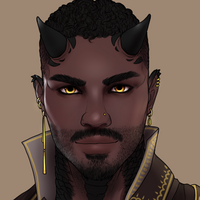 | |
| Race | |
| Pronunciation | Song-gah-ski-an |
| Classification | Human |
| Subraces | N/A |
| Common Nicknames |
|
| Languages | Sofaal |
| Naming Customs | Malian names found on earth [1] |
| Racial Traits | |
| Distinctions | Half-Draconian descendants of the Bronze Dragons |
| Maximum Age | 250 |
| Eye Colors | Amber/Orange reminiscent of fire |
| Hair Colors | Jet black, snow white, sandy brown/blonde, or dark-muted-brown. |
| Skin Tones |
|
In the far-off sands of Farahdeen stands the towering pearl cities of the Songaskian Masaya, home to the heirs of the Elders and the Great Old Ones. While commonly covered in desert, the total landmass owned by the Songaskians is twice the size of the Regalian Empire, and is commonly said to have the most well-equipped and trained professional army in the world. The Songaskians, being relative newcomers to the world, have rapidly mobilized onto the global stage, and played pivotal roles in all the recent events. Some of the last remaining remnants of the Dragons, the Songaskians have proclaimed themselves the inheritors to the guardianship of the world, a title once held only by the majestic winged creatures that roamed the skies and lorded over the mortal Races. Poised to strike from the great cities built by their Sariyd forerunners, the Songaskians spread their proverbial wings across the oceans, gathering resources and manpower to achieve their own goals of a great utopia of biodiversity and life, which they of course are the leaders of through benevolence. Others yet continue to follow in the footsteps of their draconian ancestors, living lives of study, self-exploration, and development to become the worthy descendants the Dragons wished them to be.
Core Identity
To be a Songaskian is to be the heir of Dragons, the inheritor of a powerful legacy of majestic and magical creatures that once controlled the elements of the world, but perished with time. Even with the return of Dragons in the modern era, Songaskians stand apart from their distant kin in that they have taken a different path. They do not attempt to revive what once was, but herald a new era with themselves as the preservers of the living and those who would combat the clutches of death and infection. Many Songaskians travel the world, seeking out places where death or evil holds sway, and fighting to protect the living while making lots of friends along the way. They can frequently be seen stalking places where the dead have risen, and where Magic has made even the kindest of people into self-serving autocrats. Their approach is often self-righteous, but always with good intentions, even if it comes across with a snark and smirk.
Magic versus Infection
While most Dragons see Magic as an infection period, with any type of Occult or Aberrant being instantly an unwanted transgression, Songaskians have a more nuanced stance. They believe that Magic by nature is a tool, one to be used and nurtured, but that true infection is the evil will of death that infects the soul through over-indulgence. Songaskians believe that Magic by itself can never be harmful even when practiced for selfish reasons, but excessive use of Magic invites a corruption of the soul that turns someone evil. For Songaskians, the terms infection and evil mean the same thing, and are interchangeably used. They believe evil is infectious, it can spread between people, and the only way to stop it, is to extinguish evil Magic users and dead things. Undead are usually exempt from this, but Songaskians are always suspicious of the sentient Undead, believing there may be great evil hidden in them that is just waiting to get out, because all things dead by nature want to spread death.
Desert Homeland
The Songaskians feel that Farahdeen belongs to them. Their Dragon ancestors once roamed its skies, and as such, they see it as a holy land, their holy land as the children of Marik. This is the core of their war with the Qadir: while no one remembers why the war started, it is continued by Qadir nomads' trespassing, and the trench front line between the Songaskian Mage-priests and Qadir clockwork engineers. They export this conflict to other countries, including Regalia, where street fights between Qadir and Songaskians are still very frequent.
Harmonic Preservers
While Songaskians believe Farahdeen only belongs to them and those who have chosen their path in line with the Dragon Worship religion, they see the rest of the world as chaotic and in need of stewardship. The Songaskians go out and solve other people’s problems for them, even if they do not like the solutions levied by the Songaskians. The Songaskians see themselves as the heirs of the so-called “Mantle of Creation”, which is an ideological concept that proposes that one species/race/entity is always at the forefront of defending life from death. The Songaskians have claimed this mantle for themselves, and impose that pro-life stance wherever they can.
Design
Mental Characteristics
Songaskians have a respect for all life. While they do not shy from fights, or killing if they have to, they spare even the lowest critters and insects as long as they can. This attitude also extends to being welcoming and charitable hosts to all people (except the Qadir). They do genuinely see themselves as benevolent, and try to do good by others, though sometimes this makes them come off as know-it-all or patronizing when they don't mean to. Songaskian culture is quite open, jovial, and self-expressive, leading to a people overall very comfortable with parties, drinking games, gambling, and a strong sense of community.
Physical Characteristics
Songaskians have two different appearances, their human form and their Dragon form. Their human form is always African-coded, identical to African-coded Ailor with very dark skin. However, there are some differences. Songaskians have amber-colored, slightly fiery irises. While most Songaskians have black hair, some can also have snow-white hair, hair colored like the sand of the desert dunes, or a very dark and muted brown. Songaskians are average to tall when compared to Ailor, and usually have a fairly athletic build with wide shoulders, even when not maintaining their physique. Their hair can be coily, curly, straight, or wavey, but also matted or braided to form dreads. Songaskians do have a male and female biological sex distinction, however, both are capable of carrying a child to term and conceiving, and as such, the Race is functionally intersex. A curious aspect about the Songaskians, is that they can turn their hair into fire, which is cold to the touch but does still create enough light to act like a lantern in the dark for them.
Sofawaati Form
All Songaskians have a Transformation called Sofawaati Form, in which they assume a body more similar to the Bronze Dragons (Bronze Dragon Marik on the Dragon Worship Page. Songaskians don't need to Transform all in one go however, they can also manifest any of the individual elements (for what the whole transformation may look like, reference the art on this page). Manifestations of the Sofawaati Form are: A dragon-like head, Dragon-horns, black or black-like or bronze scales on their whole or parts of their body, Draconic-tail, digitigrade legs with Dragon-claws, pointed ears. Sofawaati Form is not a Disguise (even if the face changes), and does not grant wings.
Heritage Traits
When designing a Character, Proficiency Points allow for a limited Ability selection with Point Buy Packs. Heritage Traits adds free Packs and Mechanics on top of that to help with cultural themes. Free Packs grant Abilities usually, while Mechanics change the way a character functions in Roleplay through subtle, and usually out of Combat ways. In essence, Mechanics just add aesthetic flair that invest in the niche of each culture. Free Packs never raise Proficiency Points, but the character must be able to purchase them normally. (ex. if a character is a certain Affinity that locks them out of a category, they cannot take that specific free pack and must choose the alternative option.) If a Free Pack grants Magic of some type, that Magic can be of any Alignment the character can normally choose, or limited to a select alignment, which will always be written in the Free Pack description.
Mixed Heritage characters (i.e. characters born from two parents of different Cultures) may take one parent's 'Free Packs' and mix and match up to 5 Mechanics from both parents, although some Peoples cannot produce Mixed Heritage children (due to Magical/Fantasy reasons).
Free Packs
- Songaskia gain the Magical variant of Safeguard Pack for free, or choose one pack from Prayer Point Buy.
- Songaskia gain the Steady Body Pack for free, or choose one Pack from Cleric Point Buy.
Mechanics
- Songaskians cannot become Undead, unless they are forced to do so, or request it from, an Ordial Entity. They can also choose to become a Primal Revenant on death.
- Songaskians are immune to harm from heat or fire sources (unless they are Magical), and do not suffer decreased visibility or choking hazard in a sand-storm.
- Songaskians do not have night vision in the dark, but can switch to infra-red sight allowing them to see people in pure darkness (but not through walls!).
- Songaskians may be able to do a perception check on Dragon Sites/Temples/Event Characters, and unlock additional interactions or learn more information.
- Songaskians can feel whether a Soul has passed into the afterlife, The Beyond, or is still alive (or Undead/Spirit) in Aloria, if they know their true name.
Language
The Songaskian language called Sofaal is based on the real life equivalent of Bambara, which is chiefly spoken in the country of Mali. It is an entirely unique language in Aloria in that it has no relation to any languages spoken anywhere else, and has a couple of words which are reminiscent of Wyrm Tongue, or Dragon language. The Songaskians have a simple first and last name naming principle, using names that are common in the countries of Mali, Burkina Faso, Niger, and Mauritania, but avoiding names that have obvious arabic or muslim references such as Mouhammed or Abdoul. Songaskian names are non-gendered, meaning they can apply to female-presenting, male-presenting or non-binary identifying individuals.
Songaskian name examples: Djene, Moulaye, Ailou, Fode, Hama, Konate, Alou, Soumba, Deni, Traore, Bintou, Nana, Rama, Mamadou, Adama, Oumar, Sisko, Bouacar, Mane.
Additionally, Songaskians have a hidden name called Doumara, or their Soul-name. This name is given at birth and kept very personal and secret, shared only to the deepest of friends and lovers of a Songaskian. Songaskians believe this name has power, and that they should take exceptional effort to make sure a Demon of the Void or Exist or Ordial planes never learns of it, because if they do, they might gain control over the Songaskian’s soul. The Doumara is always a noun or adjective or combination in the Sofaal language that has some relation to the Songaskian’s birth. For example, a Songaskian might be born in the afternoon, so their name becomes Tiléden, or afternoon child in Bambara. Another example might be Siramugaman, meaning orange, referencing the child was born in orange cloth.
Religion
Songaskians by far and large follow Dragon Worship, though they have their own name for it, called Mussaktu, or "gratefulness for living". Those Songaskians that worship Dragons generally consider themselves somewhat apart of the other Dragon faiths, because they are the inheritors of Dragons, believed to have been made out of the bodies and souls of the Black Dragons who perished in the Great Storm. As a result, Songaskians consider themselves more hallowed among equal Dragon worshipers, and generally mostly bestow their favor on Marik, who is called Masa in the Songaskian Language. It is not unheard for for a Songaskian to change their favored Dragon from Marik to any other Dragon however, it is unusual, but life events sometimes dictate a necessity to change ideology, especially in Regalia where some of the haughty stances encouraged by Marik worship become untenable. Songaskians also don't just exclusively worship Marik, other Dragons are also encouraged and shrines for them built, it is just that Marik is generally given a more preferential place, even if not chosen as favored Dragon.
Families
Half Songaskians are celebrated among the Songaskians. From a cultural point of view, they are just Songaskians to the Songaskian people. Half Songaskians always have the same skin-tone as full Songaskians (if you do not want to play a Half-Songaskian with Songaskian skin-tone, play a Half-something else).
Childhood
Songaskian childhood is fairly standard, similar to Ailor households. Songaskians are strictly anti-slavery, but also have a fairly misunderstood anti-prisoner sentiment. Within the Songaskian Masaya, Regalian prisoners who were imprisoned during the First and Second Songaskian Wars found that they would not be thrown into dungeons like Regalia normally does, but were instead given to Songaskian families to live with them and often even raise or interact with their children. While precautions were made to ensure the prisoner would not harm the children, the goal was always to teach the children internationalism, other Race perspectives, and often even language or fostering interest in all things foreign. Indeed, the same thing was applied when the Regalian Prince was captured, and imprisoned at the palace together with the Songaskian Massya, who would later inherit his father’s throne, applying his friendship with the then-future Regalian Emperor to broker peace with Regalia. As such, many Songaskian children have memories of these prisoner-tutors, who would often end up becoming life-long friends. The only exception to this are the Qadir, who are never taken prisoner.
Adulthood
Songaskian adulthood is fairly high quality, especially in the Songaskian Masaya. The Masaya has a very well-developed social system, and while nobility and politics are absolutely cut-throat with whole families being purged for saying the wrong thing, commoners live an absolute life of bliss, aided with Magic (but never Technology!). Each person contributes to their ability and is afforded to their needs, creating a weird culture shock when Songaskians reach Regalia and find that Regalia has severe poverty and racial discrimination, a concept that is foreign in Farahdeen (except, of course, against Qadir). Most Songaskians are assigned jobs in adulthood by the state, which is sometimes why some Songaskians seek the life of an adventurer in the wider world, being able to decide where to go by themselves.
Romance & Gender Norms
Songaskians apply the more common romance norm of monogamy, though since Songaskians are functionally intersex, they don’t really have a gender-dominant society or a concept of mother and father. Parents are always parents, and same-sex relations are very common, upwards to half of the Songaskian race is same-sex oriented. Gender norms also don’t really exist, the only gender norm that sort of exists is that most Mussaktu Priests are expected to be women. Why this is the case is not known, it just has always been that way. Songaskians are generally apathetic to all other matters of gender identity.
Politics
Songaskian society is dominated by the Songaskian Massya, which is their equivalent of Emperor or Empress, not to be mistaken with Masaya, which means Empire. The Songaskian Masaya is very similar to the Regalian Empire, in that the Songaskian state has an autocratic nobility that oversees the day-to-day running of the Empire, while the Massya himself is mostly a cultural and religious figurehead. Unlike Regalia, however, the Songaskian Masaya does not have hereditary nobility. Nobility among the Songaskians can be given and taken away in single generations, and all children must always progress with ambition and ferocity, while most Nobles in Regalia can afford to become lazy and settle in sedentary positions of just using their privilege and finances without lifting a finger for it. Laziness among the Songaskian nobility is punished immediately with having privileges revoked. Songaskians often rise to nobility through major feats, like winning important battles or passing an important reform. Some families do function with effective hereditary nobility, but only because they push their children every generation to do better and to re-earn their position in life.
History
The Songaskians are relatively new to the world, having only been around for several centuries. When exactly these events took place is hard to record, but their first appearance was directly following the Great Storm in Farahdeen that would see the Sariyd Empire destroyed and their empty and abandoned cities being taken by the Songaskians as their new pearl cities. The Songaskians essentially replaced the forerunners of the Qadir, with only the modern Qadir being descendants of the people who lived in the poor hinterland provinces, far away from the center of the Sariyd Empire. The Songaskians see their birthplace in Kouriyasui, a series of holy mountains in their faith where the Black Dragons took their last stance against the Sariyd army of machines and automata that had been built to destroy them. After decades of warfare, the Dragons were finally pushed into a corner, and in their dying moment, they cast a spell so terrible as to summon the desert winds against the Qadir, grinding their machines to a halt, and choking them out as the sun was darkened in the sky. Immediately afterwards, the Dragons disappeared, and the Songaskians stepped out of the sandstorms, settling the land.
Since then, the Songaskians have established the Songaskian Empire, or the Masaya, which controls the majority of Farahdeen save for the Al-Alus peninsula, where an eternal battle still rages between the Qadir and Songaskians. No actual casualties have been recorded for over a hundred years, with the Qadir content on sending waves after waves of Clockwork machines into battle, which the Songaskians answer with armies of necromancer minions and magical apparitions to defend their land and try to push the Qadir back. The war frontline is a hellscape that no living thing treads, with constant hordes of zombies attacking towering machine giants. These zombies don’t count as corrupted dead, because they are mindless and controlled by Magic, the Songaskia often terming them Necroservants. The Songaskians still want to push the Qadir out of the continent, and the Qadir still want to push the Songaskians back and retake some of their lost Sariyd heritage, so the war continues on.
Emperor or Puppet
There is a very lively debate around what the Songaskian Massya actually is. For several years now, the Songaskian Masaya has been in a near state of Civil War. During the First Songaskian War, the Regalian Empire was defending against the Massya’s father who wished to establish geopolitical dominance of the Songaskian Masaya over Regalia. When that war ended and the Massya died, his child son was put on the throne, who had positive connections to a Regalian Prince who was imprisoned at the palace after the first war for a while. This Massya suddenly took a very pro-Regalian stance, and suffered a coup at the hands of his uncle who then enforced a very anti-Regalian stance, resulting in the Second Songaskian War, which Regalia won, to re-establish the young Massya on the throne, and exile the uncle to the far provinces.
Since this period, the uncle has encroached on the Massya’s political power base again, however the Massya is not completely powerless either. The Masaya is caught in a very delicate balance of ideology between pro and anti Regalian, and it is not so easy to really call either side entirely in favor or against. For example, the uncle still uses Unionist advisors and Regalian weapons, while the Massya is also known to command espionage missions to Regalia to discover state secrets. Indeed, many Regalian nobles still believe the Massya to be a child, however he has become a capable and witful young man who seems to have his own agenda, even if his lingering fondness for Regalia remains. He is often accused of being a puppet in the Masaya also, but these accusations are hardly ever rested in fact and more often than not political theater as a distraction for other motivations. Songaskian politics are complicated, and anyone portraying them as a black and white comparison only displays their own ineptitude to understand the nuance and subtext of the Massya and his uncle’s interactions.
Qadir Nuance
Qadir relations are nuanced. The hatred Songaskians feel for Qadir is not eternal, meaning, there are circumstances in which Qadir can become “good” Qadir in the eyes of Songaskians. They require one of two circumstances. One, the Qadir converts to Mussaktu thus implicitly rejecting Sariyd heritage and demands, thus calling for Al-Alus to convert also. Two, the Qadir acknowledges and proclaims that Farahdeen belongs to the Songaskians and the Mussaktu faithful, and that they will not try to reclaim what they lost, thus explicitly rejecting the state of Al-Alus as illegitimate. Under these circumstances, Qadir and Songaskians can become friends, though both choices are obviously problematic for the Qadir’s relations with revanchist Qadir who still want to retake what they believe is theirs by right.
Songaskian Pearl Cities
Farahdeen is a massive desert many times larger than the entire Regalian Empire, with only select established routes of travel going through the many deserts and with even less Pearl Cities that are actually inhabited. There is a total of 14 (2 held by Qadir) cities, though Kouriyasui is not really considered a city as it is largely inhabited by the dead of the Choir of Dreams. As such, all Songaskians who were born in Farahdeen were either born en route to, or in one of the following cities:
- Timbardena is the northernmost Pearl City with the most lush climate, being situated between a series of oases. Timbardena is the only city with a forest, and as such is a major exporter of furniture. It is a very isolated city that can conventionally only be reached by traveling by the coast, or through Kouriyasui.
- Kourimou or Kourimoptoi depending on one’s spelling, is a coastal Pearl City that harvests the majority of the pearls in Farahdeen, in the bay of Kouriya. The pearls harvested here are used to produce the special paste for the bone-white walls of the Pearl Cities that prevent sand from sticking to the stonework.
- Diabaleni is a major shipyard Pearl City responsible for building the majority of the ships of the Songaskian fleets.
- Moptou or Moptoi depending on one’s spelling, is a coastal Pearl City that is conventionally seen as the piracy capital of the Masaya, where the majority of the corsairs depart from to Essalonia.
- Diernali is the main export staple market for Songaskian Gold, and also the Pearl City that has the highest Gold production. As such, some remark that the city reeks of death, on account of large hordes of Necroservants controlled by Ordial Mages performing basic labor tasks around the city, and the actual living having their abodes on a raised platform high above the lower streets. This city is as a result also infested with crime, because zombies can’t witness theft and literally don’t live to tell the tale. Those born in Diernali are not lovingly called anything, in fact they are often called greedy and self-serving, Ourat being a term that is used to describe a person who is “like a zombie addicted to gold”.
- Shaaq-Turnaal is an average Pearl City, though it is distinguished in modern times as being the first city to fall to the Regalian army during the Second Songaskian War. This city is incidentally also where the then Emperor of Regalia Cedromar commanded the execution of 40,000 unarmed civilians to show the Songaskian Masaya that Regalia would not be afraid to use genocide against the Songaskians to speed up the end of the war, forcing the Massya’s uncle to the negotiating table and eventually losing the throne for the sake of preventing future civilian slaughter.
- Massoilagui is an average Pearl City that has nothing special about it besides that it held out long enough to see the end of the Second Songaskian war without being taken, despite numerous sieges. Massoilagui as a city has a particular immigration policy against Dwarves and Eronidas, remembering the savage destruction these two Races inflicted on the countryside near it during the siege under the Regalian banner.
- Bou Gasagou is an average Pearl City. There is nothing overtly remarkable about it beyond the extensive libraries that are built in the city’s so-called Marouats, tall spire-like buildings with pointed roofs that stick out far above the Pearl walls, from where scholars perch on the highest balcony to shout debating dissertations at each other across the roofs. Those born in Bou Gasagou are lovingly called Boubou’s, which is a way of saying “someone who likes to shout at others”.
- Sikassaro is an average Pearl City, but it is distinguished in that it has a very large Allar minority living in it. Sikassaro as a Pearl City has a very diverse biosphere in the ocean near it, which is a very popular harvesting location of ingredients used in Alchemy.
- Korbamakora is the capital of the Songaskian Masaya which sits defensively between the Khatil-Assatola and Khagargoro deserts. It is a massive city with 3 million inhabitants, potentially being the second most inhabited city in the world behind Regalia’s 4 million. This city also has the largest dome construction underway, with the majority of the support infrastructure already being complete, and work having been started on the final enclosing dome that should make the city its own self-contained environment. Korbamakora is also home to the Massya’s palace, the Songaskian state offices, and the headquarters of both the College of Priests and the religious institutions. Songaskians born in the capital are lovingly called Korbas, which is a way of calling them stuck-up or self-righteous, even for a Songaskian.
- Dogono is a major Pearl City oriented around the military, with massive parts of the city just being military barracks and training centers. Dogono is in theory the frontline should the Qadir ever push north, but the Songaskians who go through compulsory military training rarely if ever see combat. However, this does not mean they are ineffective and untrained. Far from it, Dogono is known as a dogged training facility that yields some of the most well-trained warriors, and even accepts foreigners so long as they stay for 3 years, and accept Songaskian lifestyle practices and rules. Songaskians from this city are lovingly called Dogours, which means something like a bucket-head (common mockery of soldiers who wear helmets) in Sofaal.
- Kankagner is the last of the Songaskian Pearl Cities in the south that is ostensibly the front line between Qadir-held Al-Alus and the Ouelessa desert (which in full is called Ouelessa boule fassa bagougou, meaning “the sand which swallows the world whole”). This city is home to the largest collection of Ordial mages in the world, who continue to fuel the never ending border conflict between the Masaya and the Qadir states to the south.
- Kouriyasui is technically a Pearl City (it has the Pearl walls), but nobody lives in it, and it is purely being maintained by an army of dead constructs to keep it clean for religious ceremonies by the Priests. The Pearl City sits at the foot of the Kouriyasui mountains, and as such is a place where the dead pass to be grafted into the mountains in their final resting place. The city's houses have mostly been converted to mortuaries, and anyone who works in the city lives in smaller settlements outside of its walls.
- Al-Alus is technically a Pearl City, though it is not held by the Songaskians. Al-Alus became the unofficial Qadir capital after the loss of the Sariyd Empire, and though it has grown in recent years, it remains much smaller than the other Pearl Cities, having barely 400,000 inhabitants.
- Istiniyye is the smallest Pearl City in existence, on the very tip of the Al-Alus peninsula housing less than 200,000 (Qadir) inhabitants. Istiniyye was in the process of being constructed when the Sariyd Empire collapsed. While the Qadir spent a long time trying to continue construction, they simply did not have the resources the Sariyd Empire did, which is why vast sections of the Pearl walls were never finished.
Song Awnisu
While Songaskians are generally understood to be able to become 250 years old, this is not actually true. Songaskians don’t actually die, ever, but become functionally catatonic at around 250 years old, after which they must be brought to the Wall of Dreams in Kouriyasui, the holiest of places to the Songaskians, deep in the Farahdeen desert. The Song Awnisu or “Goodnight, people of Songaskia” in Sofaal, refers to the fact that these dying Songaskians are grafted into the mountains of Kouriyasui, where they join the Choir of Dreamers. These Songaskians don’t actually die, but join a collective consciousness that dreams their past lives in vivid details, and even allows Songaskians who visit Kouriyasui to experience these past lives and memories in visions simply by being there. Songaskians do not fear the coming of death, as even Songaskians who fall in battle do not fully die, and can still be grafted into the mountains that once witnessed the dying echoes of the Black Dragons. The only death the Songaskians fear, is having their hearts and minds stolen by Demons, for they will not be able to witness the choir of past lives.
World View
World View is optional content that helps give Songaskians flavor and depth.
- Curiously enough, Songaskians are actually okay with Vampires. So long as they try to adapt to civil society and live by the rule of law (and can secure their own blood cattle without slavery), then the Songaskians see no reason to force cure them, kill them, or imprison them.
- The Songaskian super welfare state is almost entirely paid for in Gold. The Songaskian Masaya is in fact the largest gold producer in the world, with zombie drones, or Necroservants, used to mine the gold and refine it, and then sold in bales to other countries. Even though Regalia has no active trade treaties with the Songaskian Masaya, Songaskian Gold always ends up in Noble banks as Bales of Gold.
- Songaskian relation to the Undead and Bintaar is complicated. Ordial to them is treated in the same way as Void and Exist, in that it is a dimension to draw power from. Death is inherently evil, but using the power of death to remove the evil of death is not. This is why Ordial mages who create Necroservants to fight machines of war are good, but sentient Undead fighting the living are not. Songaskians often cleanse (kill) the Undead in Farahdeen.
- Tawhroon is a popular aspect of fashion: the Songaskian art of using semi-permanent gold paint on the body, usually in straight or curved lines. Many Songaskians practice it, as it is meant to showcase opulence and wealth.
- Songaskians culturally despise wearing headcovers, because it blocks them from the sun. They believe that if they wear hats or any kind of head cover, they are denying the sun’s ability to peer into their soul and judge them, which is a crime against their god. This was part of Songaskian repression in the past in Regalia, requiring all faithful to wear hats in order to avoid being expelled or burned for being heretics. Luckily this law was done away with long ago, but Songaskians still feel resentment over such targeted humiliation.
- The Songaskians don’t really have a concept of separation of religion and state. The Mussaktu Priests are very powerful in daily life, and they are even enforcers of Masaya law, which lacks its own military guard force. Criminals that cannot be rehabilitated are executed with the sundial, allowing the sun to be focused and reflected off massive golden sun disks to redirect to a focal point and incinerate the criminal.
- The Songaskian Masaya is the only country/state in the world that has compulsory military service. Once Songaskian children reach adulthood, they have to go through 3 years of compulsory military education unless they are sent abroad on state business, or leave before then, or become adventurers. In this compulsory state service they are taught military formations, orders, and usually combat with a spear and shield. Mages have their own battalions where they are taught combat magic and restraint to prevent the Magic from tipping over in their soul.
- Within the Masaya, other racial minorities do exist, but many exist in bubbles. There is not so much racial discrimination as there is a general lack of knowing exactly what to do with them. While Songaskians have a clear place in Songaskian society, the Songaskians are not yet able to determine what to do with, for example, Eronidas immigrants. As such, many of them default to the entertainment industry, working in theaters, bars, and restaurants.
- A Songaskian sport frequently engaged in is Sand-ball, a sport with a circular arena filled with fine sand. On each end of the arena is a goal with a goalkeeper in front of it. Only the goalkeeper can touch the ball, all other players (5 on each team) must use sand telekinesis to move around the arena hovering on sand-devils, using sand telekinesis to spout forth sand and shoot the ball around the arena. The game is played in 3 sets of 15 minutes, with the highest amount of times of the leather ball going through the goal of the opposing team being the winner.
- The Songaskia have a group within each of their cultural divisions called the Dongilitariku. Part musician, part story-teller, it is their job to record or rely events of the past or recent years with musical flair for celebrations and to pass on their cultural traditions to the next generation. Outsiders at parties or receptions often do not understand the stories being told, as they are usually only in the Songaskia tongue, but the dancing and music that goes along with them is entertainment enough to keep their attention.
- Songaskian parents are often very “tough love” towards their children. Whether as adventurers or in military service, there is a period of 3 years during which Songaskian children are completely cut off from their families to learn how to survive on their own. After this time, a joyous reunion is held and the member is welcomed back into the family. Sometimes this does not go as planned, and Songaskians end up stranded and anxious for the judgment of their family, never returning.
- Songaskian food more often than not involves stews and earthenware pots with closed-circuit cooking environments in a large fireplace or oven. Songaskians are communal eaters and it is very common for a Songaskian to make a dinner for 10, and invite neighbors over every evening for dinner, so long as they bring the alcoholic beverages and the party attitude.
- An often overlooked topic is Songaskian piracy. The Songaskian Masaya does not produce much in the way of goods, and the gold export is controlled by the state, so many mid to low level Songaskians who need additional income resort to piracy. This is a major sticking point for Regalia, which is very anti-piracy, and this has resulted in many conflicts. Piracy is however the only way for some coastal regions to make money: Farahdeen is such a blighted desert with so many people living in it that all resources are tied up making sure everyone lives with a high living standard, but the continent only has enough to do exactly that.
- There is no difference between a Pearl City and a regular City. There were once 16 Sariyd regional capitals, 14 of which fell into Songaskian hands following the Great Storm, with the rest being in Al-Alus. These are the only cities that exist in Farahdeen, but they are absolutely massive, each of them having at least 1 million inhabitants. Songaskian society is by far and large concentrated in these Pearl Cities, with no smaller “cities” existing anywhere else, and only small settlements or college towns existing out in the wild deserts.
- Songaskians hate Clockwork because it touches the dead, at least in their eyes. Songaskians can see the Soul Rivers, and can see that when a Qadir uses Clockwork, or cycles Soul Essence, that it touches the Soul Rivers and pulls it along, passing through the device. Songaskians understand that the Soul Rivers are a form of pristine afterlife, connected to the Song Awnisu, and that by cycling through Soul Essence, they believe Clockwork to be stealing the memories of the dead. Whether this is true or not does not matter: to them, nobody should touch the Soul Rivers.
- The Songaskians don’t necessarily hate or like the Void or Exist, but they are uniquely tolerant of it. While most other Races either flatout hate it or have a specific distaste for hostile Magic or Magic used for selfish reasons, Songaskians are very sober about it, and their focus is on overuse. Songaskians believe that all Void/Exist users have a so-called tipping point, which is reached by the user using more and more of their magical power without restraint, becoming addicted. When that point is reached, Songaskians believe the Magic user has become evil, regardless of whether they are Void, Exist, Ordial, or Primal, and must be destroyed. As such, Songaskians preach moderation with Magic usage, but don’t care if the Magic user is a horrible flesh blob.
- Songaskians are anti-body modification beyond tattoos and piercings. Anything that involves replacing lost limbs with technology or intentionally mutating oneself is considered disgusting. Songaskians encourage a view of self-perfection, and so to muddy that with ugly looking mutations is considered vile.
- Every Songaskian or Half-Songaskian born inside or outside of Farahdeen has an automatic right to Songaskian citizenship within the Masaya, even if they live in states that are formally enemies to the Masaya, and even if they do not follow the Songaskian religion. Though, for these immigrants, reaching important places like college libraries may be difficult.
Trivia
- Songaskian army divisions across all forms of combat taught in the military often defy popular social beliefs in other countries, especially on the subject of brotherly love. Some women or men-only battalions encourage romance between the soldiers, believing it strengthens their bond.
- Songaskians get slightly offended by Slizzar imitating Songaskians, because they see themselves as inheritors of Dragons, and to mimic them without having profound respect for the sacrifice of the Black Dragons or the suffering they went through at the hands of the Sariyd is offensive.
- Songaskians do consider Slizzar born by a Songaskian parent who adopt Songaskian culture and naming as a 'true' Songaskian, and accept them fully. This is only if the Slizzar chooses Songaskian society over Slizzar society, however, and they are not welcomed if they cling to aspects of Slizzar society instead.
- Songaskians are immune from heat overexposure and can remain in the desert’s blistering sun for days on end. Dehydration and eye damage however does still affect them, so even Songaskians use care to garb themselves appropriately in the deep deserts.
- Because Songaskians are not observed to die in Aloria, Ordial entities and visitors report that very few Songaskians reside in Bintaar, something that annoys a great deal of Ordial entities (beyond the annoyance at the Songaskians destroying many Bintaar plots in Aloria by killing their agents in the world of the living).
- We know the page has too much art on it, and it flows over beyond the end of the text on the page. We will not be apologetic for how hot Songaskians are, and how everyone should have more of them.
| ||||||||||||||||||||||||||
| Accreditation | |||||||||
|---|---|---|---|---|---|---|---|---|---|
|
| ||||||||
